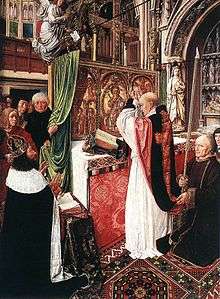Apologia ad Guillelmum
Bernard of Clairvaux's Apologia ad Guillelmum was written in 1125 at the ostensible request of his friend and fellow monastic reformer, William of Saint-Thierry, and is the key document in the early twelfth century controversy over art, the greatest controversy over art to occur in the West previous to the Reformation.[1]
Already in the Early Christian period, there was disagreement within the Church as to the appropriateness of religious art. While the use of religious art gradually came to be accepted by the mainstream, its rejection within certain limits remained a constant throughout the Middle Ages. In the twelfth century, certain elements within reform monasticism (especially the Cistercians but also others) saw the use of art by monks as inappropriate for a number of reasons. Criticism of the use of monastic art was seen as a criticism of the greatest patrons of religious art of the time, traditional Benedictine monasticism (virtually all of the greatest medieval art up until this time had been religious). Since traditional Benedictine monasticism was one of the richest and most influential segments of society—and since art was one of the great vehicles of interaction between traditional monasticism and the lay public, this interaction being an important source of wealth for monasticism—the controversy over art that arose involved far more than aesthetic questions.
The Apologia is the most articulate document we have for this controversy and one of the most important in understanding how medieval art was used and perceived. In it, Bernard takes up five major criticisms of the use of monastic art.
Art to attract donations
The monastic investment
Perhaps Bernard's harshest criticism of the monastic use of art addresses the economic base of monastic art production: the monastic investment in art for the purpose of attracting donations from the visiting public. In doing so, he takes up a number of different themes such as the justification of investing in art, art for the honor of God, the relation between material and spiritual prosperity, and the financial necessity of pilgrimage art.
The liturgical artwork

In discussing the artistic means by which the investment in art was carried out, Bernard particularly criticizes excess in art, focusing especially on excess in material, craftsmanship, size, and quantity. In this criticism, what he most objects to is not monumental sculpture and painting but rather liturgical art, that is, works often of gold, silver, and jewels that were used in the liturgy and often in the Cult of Relics.
The equation between excessive art and holiness
In his critique of the reception of art on the part of the general public, Bernard took up the indispensable element of medieval pilgrimage art: the equation between excessive art and holiness, that is, the use of excessive art in order to create a sense of praesentia (the physical presence of the holy).
Art in opposition to the care of the poor
Following in the patristic tradition, Bernard also sees art as in opposition to the care of the poor, his most significant social objection external to monasticism properly speaking.
Art as a spiritual distraction to the monk
One of Bernard's most important criticisms of the monastic use of art is that of art as a spiritual distraction to the monk. Aside from simple distraction, this criticism includes such dangers to the medieval monk as curiosity and materiality.
To Whom the Apologia Was Addressed
While the traditional view has been that the Apologia was directed at the art of the monastery of Cluny in particular and that of other offending Cluniac and traditional Benedictine monasteries in general, more recent scholarship has shown that the Apologia was instead directed at not only all of traditional monasticism but also marginal traditional Benedictine monasteries, the new ascetic orders (Carthusians, Gilbertines, Premonstratensians, and so on), and Bernard's own Cistercian Order.[2]
References
- Rudolph, Conrad (1990-07-01). The "Things of Greater Importance": Bernard of Clairvaux's Apologia and the Medieval Attitude Toward Art (First ed.). Univ of Pennsylvania Pr. ISBN 9780812281811.
- Rudolph, Conrad (1988-01-01). "Bernard of Clairvaux's Apologia as a Description of Cluny, and the Controversy over Monastic Art". Gesta. 27 (1/2): 125–132. doi:10.2307/767000. ISSN 0016-920X. JSTOR 767000.
General references
- Conrad Rudolph, "The Scholarship on Bernard of Clairvaux's Apologia," Cîteaux: Commentarii Cistercienses 40 (1989) 69-111